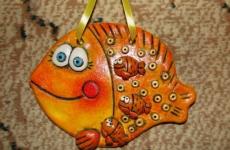What can be made from a ring. How it's made: DIY silver ring. Spiral ring as a pattern
Shall we move on to the photo report? ;)
The workshop is located at the developing Crystal plant. Since it was already getting dark, it was raining and I was late, I didn’t take pictures of him. But it is very atmospheric, so I illustrate the story with a photo from the Internet:

The plant is located near Yauza, across the river from Winzavod and Artplay. Now, when I was looking for a photo, I saw that the plant will be reconstructed: they plan to create a pleasant public space with cafes, shops, creative offices and more. Already last summer there were fairs and festivals there, many people visited the new place. The concept and appearance are reminiscent of the Bottle design factory, isn't it? Competition! :)
But about the plant another time, I want to return there when the weather is better to explore a new party place;) And now let’s return to the master class, which took place in the creative workshop. It is combined with a small but nice photography studio, so there are a lot of cameras of varying degrees of vintage, paintings and paint-splattered easels. Atmospheric place!

This is what a jeweler's workplace looks like - nothing luxurious, but not only silver, but also gold and precious stones are processed here. At the bottom there is a pedal for the sanding machine.

First we took a small amount of silver and melted it.

After this, the molten mass was poured into a mold, where it froze, but not tightly. In general, silver is a fairly malleable metal and can be worked with for some time without further melting.

Having cooled the resulting “sausage” in cold water, we moved on to running-in. It occurs in two stages: first you need to set the width of the ring (the right side of the machine), and then the thickness (the left side). You insert the sausage into the opening, turn the handle and it crawls through the hole. The running-in takes place gradually, with approximately 30 spins at each stage. That is, you cannot immediately take and flatten the metal in one scroll - then it will crack and you will have to start over.


During the last scroll, it was possible to imprint some pattern on the metal (it's still soft, remember?). They offered me a piece of lace, something else - I chose a leaf, because just recently I got a ring in the form of a twig, and I decided to make this ring for the phalanx. It turned out to be such an eco-theme :)

After that, using a thread, I measured the circumference of my finger and cut off the required amount. This was difficult, because the jigsaw needs to be held strictly vertically and ensure that it does not “move” to the side. They helped me here, since this is an important stage - the cuts must be perfectly even in order to be joined later.

Then a ring is formed from the strip around a cone-shaped stick using a soft hammer. I'm very focused and tense :)


Now it's time to bleach the silver in acid to return the original color - it darkens after remelting.

Next stage: sanding in several ways. First, the side edges of the ring are sanded using sandpaper.

Then the outer and inner sides are sanded with sandpaper rolled into a drill. The ring must be held tightly, otherwise it may fly out into the eye. And this is not so simple, because it vibrates strongly under the influence of the drill - it flew away a couple of times, so I preferred to photograph this stage :)

After this, the ring goes through the final stage of grinding on a machine with a rapidly spinning rubber “wheel”. Due to rapid friction, the ring instantly heats up and after each touch to the “wheel” it must be immersed in cold water.

That's it, the ring is ready! All that remains is to clean it in an ultrasonic bath - leave it there for 10 minutes. You can rest and wipe the sweat of zeal from your forehead :)

And here is the result!

An indescribable feeling when you make something yourself: now I wear this ring without taking it off - here it is, the power of handmade. So I advise you to go to the master class, it is not at all expensive. Or an option for guys: buy a certificate for MK and give it as a gift on February 14 or March 8;)

Thanks to my jewelry mentors who helped me create the photo report!
 Did you know that you can make a finger ring with your own hands? This original and individual gift will become truly expensive and special for your loved one. He will be able to express the depth of feelings, or simply help you make an extraordinary decoration that everyone will pay attention to. This will be a source of pride!
Did you know that you can make a finger ring with your own hands? This original and individual gift will become truly expensive and special for your loved one. He will be able to express the depth of feelings, or simply help you make an extraordinary decoration that everyone will pay attention to. This will be a source of pride!
 Most common materials:
Most common materials:
- metal;
- tree;
- resin;
- beads;
- buttons;
- paper;
- coins;
- wire;
- zipper;
- polymer clay.
 All these materials can be used to make a finger ring at home.
All these materials can be used to make a finger ring at home.
The most attractive, but Metals are considered difficult to process. They will add durability and external gloss to the product. The characteristic metallic shine will only emphasize the uniqueness and unitarity of the ring.
 Plastic and wood less durable, but will be able to create the effect of a “handmade product”, which is so appreciated by a certain segment of people. Such materials are more fragile and susceptible to corrosion and deformation. For example, wood may turn black and plastic may crack.
Plastic and wood less durable, but will be able to create the effect of a “handmade product”, which is so appreciated by a certain segment of people. Such materials are more fragile and susceptible to corrosion and deformation. For example, wood may turn black and plastic may crack.
Ease of processing compensates for these shortcomings, which allows the use of these materials on a par with metals and others.
It is worth considering that there are entire training master classes from famous decorators. In classes, under the strict guidance of a decorator, you can study the topic and make the ring with your own hands even more attractive and complex!
Paper and resin- less interesting material to work with. The appearance of the product may look interesting. The flight of skills and imagination is unlimited!
Various rings
Today we will look at several options (instructions) on how to make a ring with your own hands.
From a coin
 You can make a ring from a coin. It is necessary to have such tools and materials, and follow the instructions.
You can make a ring from a coin. It is necessary to have such tools and materials, and follow the instructions.
Decorators recommend using 10-ruble Russian coin, It has the right size and a pleasant silver color. However, no one limits the choice of coin, there are only recommendations. You can use foreign coins, which will allow you to leave unusual inscriptions from coins on the product (names of foreign banks, names of historical figures, etc.).
Necessary drill a hole inside the coin, on which the coin must be placed on the rod.
Putting a coin on a metal rod, it must be periodically heated so that it loses its “solid properties” and the metal can be deformed using targeted hammer blows. You need to hit the “ribs” (edges), flattening the ends.



Using an incandescent lamp I, the coin must be given a static, heated temperature, which made it possible to make a ring.
After all manipulations, the finished product must be cooled and polished with (fine-grained) sandpaper using a commercial polish (to a shine).
Made of wood and plastic
 A ring made of wood or plastic is made by giving the product a certain shape desired by the master.
A ring made of wood or plastic is made by giving the product a certain shape desired by the master.
For this You can use drills and sandpaper.
Need to take a small piece of wood or plastic and drill an entrance for your finger in it. Next, you need to treat the entire surface of the product to create a pleasant appearance (shine). Ready!
The master can make a product for two fingers simply by taking the appropriate shape of the workpiece.




Above You can glue decorative elements(cut from the manufacturing material and processed with sandpaper), which are manufactured separately (depending on the desired model). You can use commercial glue to attach them.
Made from paper and resin
To make a model from paper, resin, ring blank required(original mold).

You can use a cheap, purchased ring, which is placed in liquid smog, and after thickening is removed, leaving behind a ready-made mold for making a new model from any material (“gel”). For example, the paper can be finely shredded and mixed with glue, which will create a kind of “gel”, which is poured into the mold.

The advantage of this method is that The mold can be used an unlimited number of times. This will allow you to recreate the product if it is accidentally lost or damaged.

After the “gel” has thickened, the product must be processed until it is shiny. The ring is ready!
These were some simple ring making instructions that any crafter or person with a desire to create something with their own hands can use! Experiment, imagine and create!
Everyone brainiacs greetings! Today I'll tell you like with your own hands turn an ordinary nut into a ring, well, maybe not quite a ring, but definitely into a signet ring.
Step 1: Materials
Nut (to fit your finger, my nut is 2cm)
Angle grinder (grinder)
dremel
file
sandpaper (220, 600)
masking tape
sharp knife
power unit
common salt solution
cotton buds
varnish

Step 2: Stitching Corners




Carefully, observing safety regulations when working with power tools, grind off the corners of the nut. You can tighten the nut in brain tests and use a grinder to round the corners one by one. Be sure to check that the material is removed evenly, and do not forget that one plane of the nut remains intact.
Step 3: Taper





When the corners are removed, we proceed to narrowing, that is, giving the nut the shape of a ring. We cut/stitch the material from the sides, narrowing it towards the bottom. We constantly check for symmetry, do not grind down too much, so as not to spoil it.
After narrowing it down under the tree Enough, we remove small chamfers along the edges of the signet and modify the shape at your discretion.
Step 4: Hole


At this stage, we pick up a suitable tool for removing the internal thread and forming a hole for the finger. I took my trusty “friend” - a Dremel, and grinded the threads for 15 minutes, so that the nut became hot.
We grind the material evenly, maintain symmetry, be sure to make internal chamfers and check how homemade sits on your finger.
Step 5: Sanding



We replace the Dremel with a file and clean and polish our brain trick, smooth out the grooves from the grinder and Dremel. After this, we complete the sanding with sandpaper of various grits, starting from 220 and up to 600.
I don't like rings that are too shiny, so I went with the level of polish shown in the photo, but you can bring the ring as smooth as you like.
Step 6: Print Design


Turn on brain fantasy and develop a design that we will apply to the ring. For example, I stylized my initials, reflected them symmetrically and drew them better so that the print was clear.
Step 7: Preparing for Etching


We will carry out the etching process by electrolysis, so we cover the surface of the ring that should be untouched with nail polish, adhesive tape or something similar. To do this, I chose masking tape, which I tightly glued to the ring, and then evenly and carefully cut out the previously invented design on it with a sharp knife.
Step 8: Etching





The etching process is quite interesting. I did it several times and I will say that everything is not as difficult and dangerous as it seems, although the smell is not very pleasant, but you can just close your mouth. And as a source brain flow I use a 12V charger.
So, we dilute the salt solution and connect the positive charger wire to the ring. We dip a cotton swab in a saline solution and attach a negative wire to it in a wet place, then use the resulting “electrode” stick to pass through those places crafts that need to be etched. At the same time, the longer you hold the stick, the more this place will be etched. Since this homemade not just a ring, but a signet, then I etched quite deep grooves so that the imprint would be clear. And the whole process took about 5 minutes and 7 sticks.
After etching is complete, disconnect the wires, wipe the signet in water and remove the tape. Perhaps in those places where the tape did not stick well, unnecessary etching resulted, but I think this is not critical.
Step 9: Varnishing


After the first day of wearing the ring, my finger became “rusty”, that is, the homemade product has oxidized, so I recommend that you cover the signet with colorless varnish. That's what I did - covered brainprinter polyurethane varnish.
Step 10: Craft ready!


The signet ring made from a regular nut is ready, thank you for your attention.
Good luck in brain creativity!
Jewelry is every girl's weakness. But what is sold in stores is sometimes so boring and unoriginal that you want something new and unusual, for example, some beautiful and unusual ring. Make it yourself! There is nothing complicated about it.
What can rings be made from?
If you decide to create something original, then use the most incredible and unexpected materials, they are the ones that make unique and creative little things. Here are some ideas:
- If you have a box of old ones (ask your mom, she definitely has one), then dig through it, you might find something original there.
- Be sure to find some wire, it will serve as an excellent base for a ring. Its thickness can be different, it all depends on your wishes.
- Beads, beads. What girl doesn't love all this? If you suddenly have old broken beads that you hate to throw away, be sure to use them.
- Old broken rings. If it happens that the ring falls off the ring and gets lost somewhere, then do not throw away the “bare” ring, it will serve as an excellent basis for a new amazing ring.
- Coins. If you have old coins, they can make great jewelry. More will be written about this below.
- Ribbons. They can be used too.
But, in general, if your imagination works well, then you can make something amazing out of any even unnecessary thing. And such decoration will be exclusive, since it was made by your own hands.
By the way, I would like to say that to make your task easier, it would be useful to acquire a cone for measuring rings; it will be an excellent stencil. But if you don’t have one, it’s okay.
How to make a beautiful ring?

How to make a ring from practically improvised materials with your own hands? First, you need to measure your finger so as not to make a mistake with the size. It's easy to do. Take paper, pencil and scissors. Cut a strip of paper approximately 5-7 centimeters long.
Wrap this strip around the finger you plan to put your ring on. Mark with a pencil where one edge intersects the other. Cut off any excess. If necessary, measure the resulting strip, this will be the circumference of your finger. You can also use this strip as a template to measure out materials.
Now we offer several options for beautiful rings.
Ring "Bow" made of ribbon
You will need:
- satin ribbon (no more than 0.5 centimeters wide);
- thick wire for the base;
- scissors;
- pliers;
- wire cutters;
- thread and needle;
- glue.
Here's what to do:
- First measure the required length of wire. To ensure the strength of the future ring, it is better to make several turns, so multiply the girth of your finger by 3 and add half a centimeter. Measure this length on the wire and cut off the excess with wire cutters.
- Now start wrapping your finger (or size cone, it will be easier) with wire using pliers. You've got the base.
- Now take the satin ribbon. Where the edges of the wire meet, glue the edge of the ribbon. Start wrapping the tape around the base. Make sure it fits snugly against the wire. When you have wrapped the entire base, cut off the excess and secure the end with glue.
- Cut a piece of tape 10-15 centimeters long; the edges can be scorched or burned so that they do not unravel (you can heat the scissors before cutting).
- Tie a bow and secure the middle with a couple of stitches.
- Glue the bow to the base (to the place where the end of the ribbon that you wrapped around the wire is attached to).
- Ready!
Coin ring

An original ring can be made from a coin, but it is quite difficult, so it is better to ask someone for help (preferably someone who has the skills to work with metals and process them). Here's what you'll need:
- drill;
- fine-grained sandpaper;
- a coin (for example, a two-ruble coin);
- a piece of metal;
- hammer;
- textile;
- tea spoon;
- emery roller;
- polishing wheel.
Let's get started:
- Take a coin, place it on its edge and place it on a metal base. Press it down with a teaspoon. Now you have some hard work ahead of you. Take a hammer and hit the teaspoon to flatten the coin. It is important to constantly monitor the process, and also strike with approximately the same force so that the edge is as smooth as possible.
- Then you need to make a hole in the center of the coin using a drill. Stop as soon as the drill goes through. The coin is secured, it will be convenient for you.
- Now sand the edge with sandpaper using a roller until the surface is shiny.
- Now use a larger drill bit to enlarge the hole. Then change the drill to an even larger one. Constantly monitor the process and try on the ring so that in the end it won’t be too big for you.
- Use an emery roller to polish the inside surface.
- Ready. Of course, it’s easy to write this, but in reality everything is much more complicated, so it’s better to ask someone to help (your husband, for example).
Ring made of beads and beads

You can make a beautiful ring from beads and beads. Here's what you'll need for this:
- wire (you will need to string beads on it, so the thickness should not be too large);
- beads;
- glue;
- beads;
- wire cutters;
- pliers.
Here's how it's done:
- Multiply the circumference of your finger by 3 or 4 (depending on the number of turns), add two centimeters. Measure and cut the appropriate piece of wire.
- String beads onto the wire. There should be one centimeter left at each end. In these places it is better to secure the beads with glue so that nothing falls off later.
- Wrap the beaded wire around your finger or measuring cone. Bend the remaining ends slightly; they will be needed to secure the ring.
- Let's start making the ring. Take the wire, cut three pieces 2-3 centimeters long (depending on the size of the bead).
- String two beads onto each piece. Immediately bend the ends (only the tips) using pliers so that the beads do not fall off.
- Next, bend all three pieces in half to form a depression in the middle, and distribute the beads to the ends. Place the base in this recess by threading pieces of wire through it. In this case, the bent ends of the base wire should be located directly next to the ring.
- Now bend the pieces of wire so that the beads are located next to each other. Twist all the ends so that the beads remain at the top.
- Secure the ring with the bent ends of the base, bending them over the wires of the ring.
- Ready.
Button ring

Every day, future spouses, couples in love and people preparing to celebrate their wedding anniversary come to the Zelenin&Yolkin jewelry workshop. The idea of how to do it came to Russia not so long ago from Europe.
The desire to surprise a loved one, please him and give him something truly worthwhile drives each of us, and creating a ring with your own hands means giving a large part of yourself in a small piece of jewelry.
Of course, after all, a master class on creating wedding rings is a symbolic and touching event, both for a couple in love and for spouses, and the opportunity to create your own individual ring design attracts lovers of exclusive jewelry.
How to make wedding rings with your own hands - master class
Let's start with the positive aspects of the master class on creating rings:

New opportunities
Many people think that they cannot create, for example, a gold ring with a diamond, because jewelry requires perseverance, a keen eye and titanic patience. However, the jewelry workshop “Zelenin&Yolkin” daily witnesses how even the most timid apprentices create real masterpieces with their own hands. Master jewelry making skills in three to four hours? Easily!
This is so lovely!

In fact, this is how guests rate rings they have just made with their own hands. It is impossible not to appreciate such rings, and the story of the creation of the ring remains in the memory for a lifetime.

New life for old jewelry
Often young people come to us with their jewelry, which has lost its pristine beauty under the yoke of “millennia”. Heirloom jewelry inherited from grandmothers and their grandmothers sometimes needs a new life. This is exactly what their current owners think. Therefore, many come to make wedding rings from their gold. Giving life to an old piece of jewelry that will shine with new colors - isn’t this a miracle?

A test of strength or an opportunity to prove yourself
This is exactly what lovers think when they take on what at first seems like a difficult job. Step by step, coping with each stage of creating a ring, guests experience indescribable emotions: “I didn’t know that I could do this!”

Exclusive rings
The female half will probably like this more. Lovers of beautiful things that will belong to them alone - in stores you will have to pay a fortune for such decoration, but here you can create your sketch the most unique ring, which will definitely be made in one single copy.
Ideal gift
Often people come to the jewelry workshop who want to make a ring as a gift: to their mother, a loved one, their best friend, their child, etc. The ring is especially valuable because it is created by hand, and the best gift is one made by yourself. A commemorative inscription, date, etc. is usually placed on the back of the ring.

Save time
It would seem that 3-4 hours, during which a master class on creating wedding rings takes place, is not so little. However, Moscow residents know that searching for rings that both spouses will like will take much more time, and disputes over the texture and design of rings without a professional jeweler may lead to nothing at all.
Disadvantages of making wedding rings with your own hands
The downside to taking a DIY ring making class is that you will actually have to put in some effort to make the jewelry you want. Sometimes people simply don’t like to “bother”, and it’s easier for them to buy than to make it themselves. In this case, in our workshop, jewelers will make absolutely any wedding rings to order.
How is the master class going?
The master class on making wedding rings with your own hands in Moscow takes place in several stages:
- Once the ring model and basic parameters have been selected, guests can begin creating rings.

- The jeweler shows how to work with precious metal and gives guests the opportunity to create a ring themselves according to the best traditions of jewelry making.

- The prepared precious metal is melted with a burner in a crucible and mixed with the alloy to obtain the required sample and color. The alloy is poured into a cast iron mold, which gives it the shape of an ingot.

- The finished ingot is rolled through a rolling press. This allows the rectangular block to turn into a blank for the required product.

- A long plate is bent into the shape of a ring, and its ends are soldered.

- The end result is an almost finished ring, which just needs to be perfected.

- The product is placed on the crossbar, and with the help of a textolite hammer it is given the ideal ring shape.

- At the next stage, you can start setting the precious stones, engraving and creating the necessary texture. After all, all that remains is to polish the treasured ring and try it on. Even seemingly simple wedding rings play with different colors and radiate the creator’s energy, warmth and atmosphere.







